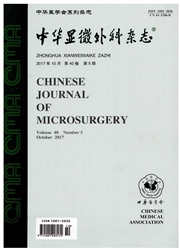

 中文摘要:
中文摘要:
目的探讨前交通动脉破裂动脉瘤的显微外科治疗临床效果。方法2009年9月至2013年2月,采用改良翼点入路显微手术治疗前交通动脉破裂动脉瘤患者33例,对临床与随访资料进行回顾性分析。结果32例随访3—44个月,疗效按GOS评分:5级28例,4级2例,3级1例,1级1例。结论改良翼点入路显微手术治疗前交通动脉破裂动脉瘤,术野暴露充分,对脑组织骚扰小,瘤颈夹闭可靠,疗效满意;术前通过CTA或DSA充分评估动脉瘤的局部三维结构,术中准确判断载瘤动脉及附近分支血管,同时采用血管临时阻断技术,对于安全夹闭动脉瘤具有重要作用。
 英文摘要:
英文摘要:
Objective To explore the microsurgical treatment strategy of ruptured anterior communicating artery aneurysms. Methods From September 2009 to February 2013, thirty-three patients with ruptured anterior communicating artery aneurysms were treated with microsurgical clipping via modified pterion approach. The clinical and follow-up data were analyzed retrospectively. Results At 3 to 44 months period followed-up after microsurgical clipping of ruptured anterior communicating artery aneurysms were obtained in 32 patients. According to Glasgow Outcome Score, the curative effects score were 5 in 28 cases, four in 2 cases, three in 1 case and death in 1 case. Conclusion Microsurgical clipping of ruptured anterior communicating artery aneurysms via modified pterional approach was an effective method with sufficient exposure. It has less invasiveness to the brain tissue, reliable neck clipping and satisfactory results. Safety and effectiveness of this procedure are based on preoperative radiological evaluation of three-dimensional morphological specificity of aneurysms, identification of the parental arteries and its branches, as well as temporary proximal occlusion.
 同期刊论文项目
同期刊论文项目
 同项目期刊论文
同项目期刊论文
 期刊信息
期刊信息
